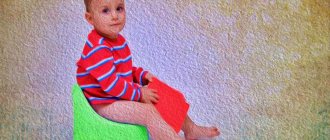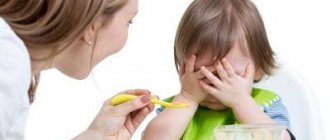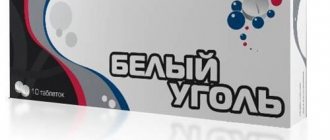A child over two years old already has a well-developed digestive system. But there are still foods he hasn't tried, so introducing new foods may affect the color and consistency of the stool.
If a baby's stool may well have a light color, the child's light-colored stool should attract the attention of the parents, since there may be a reason in the diet, or it may also be hidden in the disease. Parents should understand the features of this condition and how they can help the baby in this case.
Normally, the baby’s stool should be brown in color and have a fairly stiff consistency, but if the child’s stool is light-colored and additional symptoms appear, then you should understand that you most likely need to see a doctor. Knowledge of additional symptoms for various ailments allows you to provide timely, competent assistance.
What affects the color of baby's stool?
The consistency and color of stool largely depends on the age of the child. During the first 3-4 days of life, a newborn produces meconium - original feces that have a dark green or black color and a viscous consistency.
After a few days, the stool becomes light in color - yellowish or whitish. The presence of a small amount of mucous inclusions is allowed. This is due to the process of adaptation of the infant’s gastrointestinal tract to new conditions and new food.
By the end of the first week of life, feces in newborn babies become light brown in color. The consistency becomes mushy and the smell becomes sour milk.
Nutrition and stool color
Light-colored feces in a child are closely related to his diet. So, in the first six months of life, children are breastfed or bottle-fed:
- Infants' stools have a lighter, yellowish tint. If the feces have become discolored, the nursing mother needs to analyze her menu and make certain adjustments to it.
- In "artificial" breeders, yellow or gray feces are found. The color of the stool may vary depending on the formula the baby consumes. A sharp change in shade occurs when dry baby food is replaced.
Factors contributing to the appearance of light-colored stools
Gray feces of a bottle-fed baby can occur if the formula is not selected correctly. It is recommended to consult a pediatrician to select the optimal baby food option.
Children 2 years of age or older may develop white stools when consuming large amounts of calcium-fortified products. Sometimes changes in the color of stool occur due to an excess amount of vitamins in the food consumed by the child.
Note. According to pediatricians, one of the reasons why a child's stool is white is teething. The reasons for this phenomenon have not yet been studied, but the fact remains a fact, and parents should take note of it. In such circumstances, you do not need to take any measures on your own - you just need to carefully monitor the baby’s well-being and, if necessary, take him to an appointment with a pediatrician or family doctor.
Medicines
The causes of loose white stools may lie in the use of certain medications:
- antimycotics;
- preparations based on acetylsalicylic acid;
- NSAIDs;
- antiepileptic drugs.
Where to go
Normal baby weight at birth - what should it be?
If you notice the first signs of problems, such as changes in the color of stool, you should consult your pediatrician.
The baby's restless behavior, crying and whims will indicate that you need to see a doctor.
The doctor will interview the parents, examine the baby, and palpate the abdomen. To get a complete picture, you will need to collect data on the baby’s behavior and nutrition and undergo examinations. In addition to a general blood test, you will need to submit a lump of feces so that a detailed study can be carried out in the laboratory.
Fluoroscopy and ultrasound will be prescribed, which will begin to collect a complete picture of the condition of the baby’s internal organs. If the examinations carried out do not give an answer, then manometry, endoscopy and electroenterogastrography, and scatology may be prescribed.
Pathological causes
The reasons why a child has white stool may be diseases of the liver, stomach, biliary tract or pancreas. The most common pathological processes leading to such a deviation are discussed below.
Acute pancreatitis. Light-colored stool in a child, along with nausea, bloating and pain near the navel, may indicate the development of an inflammatory process in the pancreas. In parallel, pancreatitis in children is accompanied by vomiting, a feeling of thirst and changes in body temperature. This condition requires mandatory consultation with a gastroenterologist.
Whipple's disease. This is a rare disease, accompanied by the release of gray stool and an increase in the urge to defecate up to 10 times a day. The patient experiences enlarged lymph nodes and a jump in body temperature.
Hepatitis. One of the most dangerous causes of gray stool is hepatitis. This liver disease is accompanied by dark beer-colored urine, bad breath, and as it progresses, the development of obstructive jaundice.
All of the above pathologies can develop in children of different ages. They require mandatory consultation with a specialist, otherwise hazardous health consequences may occur.
Gilbert's syndrome. Stool discoloration in children with Gilbert's syndrome is accompanied by an increase in the level of free indirect bilirubin, accumulation of lipofuscin pigment in the liver cells and the development of jaundice. This is a hereditary disease that develops against the background of a defect in the microsomal enzyme UDPGT.
Gallbladder diseases. Discoloration of stool in children can be a consequence of the development of cholecystitis or cholelithiasis. A similar deviation is also observed when the organ is bent, which is not so rare in pediatric practice.
Gallbladder diseases lead to disruption of the flow of bile. The consequence of disruption of its entry into the intestines is a significant lightening of the stool.
What does yellow stool with diarrhea mean?
Diarrhea in itself is a dangerous symptom for babies, but if a child poops with a yellow liquid structure, then this primarily indicates a lack of the enzyme bilirubin in the body, which is produced by the pancreas and, with the help of the gallbladder, enters the stomach to process food. If parents If you notice such a combination of violations, then you should understand that one of these organs is not working correctly.
In this case, yellow stools can be caused by several reasons:
- Disturbances in the functioning of the gallbladder, such as bending of the bile ducts or inflammation of the organ itself.
- Rotavirus infection. In this case, dehydration of the body occurs, so yellow stool with mucus is observed during the first two days of illness, and then it completely becomes gray. Without qualified treatment, a child may even poop water.
- Dysbacteriosis, which appears as a result of an incorrect ratio of beneficial and pathogenic microorganisms in the intestines.
- Damage to the intestines by infectious pathogens that inhibit beneficial microflora.
In all these cases, you must contact a specialist for qualified help. Only a doctor will be able to diagnose and identify the exact cause, since often these ailments have many similar symptoms.
When should you be wary?
If a child has light-colored stools, then the parents’ special attention should be drawn to the presence of symptoms accompanying this deviation:
- increased body temperature;
- a sharp decrease in the child’s weight;
- loss or decreased appetite;
- flatulence tormenting the baby;
- change in urine color;
- child's complaints of pain in the abdomen;
- yellowing of the skin or sclera of the eyes.
Older children may also complain of bitterness in the mouth and pain or heaviness in the right hypochondrium.
White stool or liquid yellow stool in a child is a good reason to immediately seek medical help. These are symptoms that accompany the previously described pathologies, and in no case should they be ignored or self-medicated!
First aid
The parents' task is to replace the fluid and electrolytes lost through diarrhea and vomiting. Therefore, first of all, the child is fed.
For this, glucose-saline solutions are used (the best option):
- Hydrovit;
- Oralit;
- Regidron Bio.
You can prepare the solution yourself. You need to mix 3 tsp. sugar, ½ tsp. salt in 1 liter of boiled water.
Often the child refuses saline solution; in these cases, children are given other drinks. The following are suitable for this: dried fruit compote, rice water, still mineral water, vegetable broths, chamomile or fennel tea. As a last resort, give any drink except sweet lemonades. The main thing is that the liquid flows.
The child is fed small portions of solutions at a rate of 100 ml per kg of body weight. The ideal option is 1-2 tbsp. l. every 10-20 minutes.
Antipyretic tablets are given only when the body temperature exceeds 38.1 ° C and in general poor health caused by fever.
Without a doctor it is permissible to use:
- antipyretic suppositories (for vomiting): Efferalgan, Tsefekon D, Panadol;
- oral medications: Ibuprofen, Panadol;
- to relieve intoxication: Smecta.
Since white diarrhea can also be caused by contagious infections, the child is isolated from others. When caring for a patient, adhere to all hygiene rules.
Without a doctor’s recommendation, a child is prohibited from giving medications that color stool (make diagnosis difficult), increase viral diarrhea, and can cause burns to the mucous membranes and other side effects. These are activated carbon and medications based on it, soldering and enemas with a solution of potassium permanganate, enzymes (Creon), antidiarrheal drugs (Loperamide).
What to do if your child's stool is discolored?
Before you take any action, you need to understand why your child has white or discolored stool. If the problem lies in nutrition, then it is necessary to make certain adjustments to the baby’s menu (stop taking vitamins, exclude products enriched with calcium or carbohydrates from the diet).
If there are no changes for the better, you should show the child to a pediatrician or family doctor, who may subsequently refer him for additional consultation with a gastroenterologist, hepatologist or infectious disease specialist (depending on the identified symptoms).
Treatment of diseases accompanied by light-colored stools
Gray stool resulting from pancreatitis may require the use of:
- analgesics;
- vitamins;
- antibacterial drugs;
- enzymes;
- choleretic drugs;
- antispasmodic drugs;
- sedatives;
- NSAIDs.
In case of hepatitis, the child is hospitalized in a hospital, where therapy is carried out using antiviral and anti-inflammatory drugs. In parallel, in addition to the main treatment, diet therapy is prescribed. It is also indicated for children with gallbladder pathologies that have led to stool discoloration.
If changes in the color of children's stool are the result of pathological processes, parents should refrain from self-medication. It is impossible to choose the right medications for your child on your own. A remedy that can be used, for example, by children 6 years old, is not always suitable for a small patient of 4 years old. And medications used for children aged 3 years may be prohibited for treating infants.
An incorrectly chosen remedy and an irrationally designed treatment regimen can cause a deterioration in the baby’s well-being, or provoke complications of the current disease.
Prevention
To avoid problems with stool in a child, parents should be careful about his diet. Nutrition should be varied, enriched with all the vitamins and microelements necessary for a growing body, and at the same time easily digestible.
Small meals have a good effect on the body. You should teach your child to eat small portions, but often. This is very useful for the gastrointestinal tract, as it allows you not to overload the stomach. Thanks to this, he has time to digest the incoming food without causing the child a painful feeling of hunger.
Don't forget about vaccinating your children. In particular, this concerns the prevention of hepatitis.
Dietary recommendations
Human food should be varied, richly saturated with essential microelements, groups of vitamins and minerals. A diet that will be complete will contribute to and will further support the proper functioning of the intestines, normalize stool and regularity of bowel movements.
For health and full strength, a growing body needs to have in its diet every day:
- Vegetable and fruit products;
- Natural fermented milk products;
- Cereals;
- Required individual amount of liquid (clean water).
Not only nutrition affects the health of children. It is important that the baby moves, plays active types of games, and spends enough time in the fresh air. This is useful not only for small children, but also for all family members. By making this a family pastime, it may later develop the child’s love for sports and nature. At the same time, all family members will become healthier, more active, and filled with vitality.











